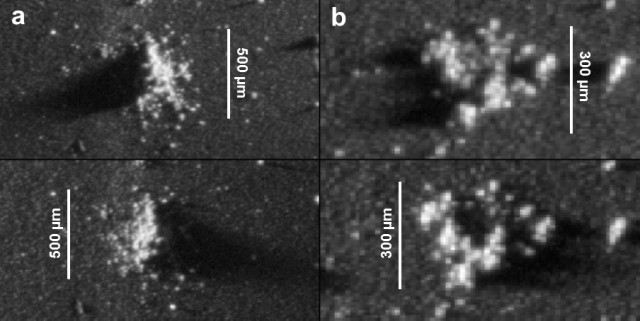 01-29-2015, 11:42 AM
01-29-2015, 11:42 AM
|
#2115
|
|
Supporter
Join Date: Mar 2003
Casino cash: $2947626
|
 Mosaic of comet 67P/Churyumov-Gerasimenko, made from four images taken by the Rosetta spacecraft. Mosaic of comet 67P/Churyumov-Gerasimenko, made from four images taken by the Rosetta spacecraft.
ESA/Rosetta/NAVCAM
The Rosetta spacecraft has been orbiting the comet 67P/Churyumov-Gerasimenko for the past few months, and in addition to taking stunning photographs and making a historic landing, it's been analyzing the comet with its onboard devices, including COSIMA (COmetary Secondary Ion Mass Analyser). The spacecraft was able to capture grains from the comet’s coma in an aerogel plate. Nonetheless, most of the grains captured this way disintegrated anyway. Although that destroyed the grains, it told us something about the comet's recent history in the process.
Aerogel, nicknamed ‘frozen smoke’, is a very soft gel which replaces the liquid in a traditional gel with gas. Because of its softness, aerogel makes a good medium for capturing fast-moving dust, as it has less chance of destroying the grain than with a hard impact. Although the grains that were captured at relatively low speeds—about 1-10 meters per second—this implied that the grains were structurally weak to not be able to survive the soft impact with the gel.
 Enlarge / The grains, collected by COSIMA. Image A) shows the dust particle named 'Eloi' by the researchers, like the post-human creatures in H.G. Wells' novel. Eloi crumbled upon capture. B) shows another particle, named Arvid, which shattered. Enlarge / The grains, collected by COSIMA. Image A) shows the dust particle named 'Eloi' by the researchers, like the post-human creatures in H.G. Wells' novel. Eloi crumbled upon capture. B) shows another particle, named Arvid, which shattered.
ESA/Rosetta/MPS for COSIMA Team MPS/CSNSM/UNIBW/TUORLA/IWF/IAS/ESA/BUW/MPE/LPC2E/LCM/FMI/UTU/LISA/UOFC/vH&S
It also implies that the grains didn’t have a water-ice component. If they did, they wouldn’t shatter in the gel—rather, the watery component would evaporate, leaving only the rocky component to be studied. And if the grain was entirely ice, the whole thing would have evaporated, leaving nothing behind.
The comet therefore has an outer layer of pure dust with no water-ice. The dust is high in sodium and fluffy. (Yes, 'fluffy’ is a scientific term, meaning porous like a sponge). The researchers concluded that the dust originated in a layer of the comet that was built up over the past four years. The comet takes six and a half years to orbit the Sun, and so for the past four years, the comet’s been in the more distant part of its orbit—greater than four astronomical units away from the Sun.
When it gets closer to the Sun, 67P/Churyumov-Gerasimenko heats up and begins to outgas, producing the comet’s coma (the atmosphere around the body itself) and its tail. This process ejects the outer dusty layer and in the process pushing the lower material, which contains an ice-dust mixture, closer to the surface.
It has been previously suggested that comets might develop such a dusty layer as they spend time far from the Sun before releasing it in the closer part of their orbit. And, on its previous close pass in 2008, this same comet was observed by telescope, shedding the dust layer it had built up. Back then, its dust was entirely lost when the comet was relatively close to the Sun at a little over two and a half astronomical units away. It reached a similar distance earlier this month, and presumably finished losing its outer dusty layer yet again. It will begin building it up again as its orbit shifts and it begins edging further into the Solar System.
The study confirms that the comet’s dust originates from the Solar System’s interplanetary dust. And since the dust is high in sodium, it explains why some comets have been observed to be high in sodium.
Nature, 2015. DOI: 10.1038/nature14159 (About DOIs)
__________________

|
|
Posts: 16,396
|

|